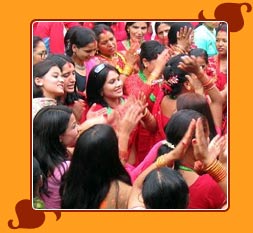According to Hindu mythology, on the 3rd
day (teej) after the new moon in the month of Shravan Goddess Parvati went
to the house of lord Shiva, her husband and was united with him. Teej is
celebrated in India especially by women in the months of July-August marking
the advent of monsoons. It has great significance in Rajasthan as it is
observed to provide relief from the scorching heat of summer. Thus, it is
popularly called the Sawan Festival.
 History
of Teej
History
of TeejThe festival of Teej symbolizes reunion of Lord Shiva and
Goddess Parvati. Teej teaches us the sacrifice of wife to win the heart of
husband. It is said that Parvati reborn and went through stringent fasting
for 108 long years to prove her dedication, devotion and unconditional love
towards Lord Shiva. Finally, 108 years of long sacrifice paid off and Lord
Shiva accepted her as his wife. Till today, the festival of Teej is
celebrated to honor the devotion of Goddess Parvati – popularly known
as TEEJ MATA. On this day, both married and unmarried women seek her
blessings for their happy marital life.
Types of
Teej In the state of Rajasthan three kinds of Teej are celebrated
and worshiped by the local public in the region. Broadly,
» On
Haryali Teej : The moon is prayed to.
» On Kajari Teej : women
gather to sing songs and a pooja of neem is performed.
» On
Hartalika Teej : Fast for 3 days without any water on the second day.
This
festival is more famous amongst the people of Rajasthan and thus the
celebration of Teej remains exclusive to the Jaipur region. Teej holds a
special place in the heart of the people of Jaipur as a time for
rejuvenation and revival of spirits after the punishing summers. The
festival is made into an even more memorable experience if it rains on this
day.
LegendThe legend behind the
celebrations is Goddess Parvati’s hard-core Tapasya, before her union
with Lord Shiva, for which she took 108 births on the Earth. The Myth goes
that she failed to have Lord Shiva as her Life Partner till 107th Birth. But
this divine union happened, when she again took birth for 108th time.
CelebrationsMarking
the start of monsoons and happiness, this festival is celebrated with great
joy and colorful customaries throughout northern India. Jaipur in Rajasthan
especially organizes a fair for tourists and people coming from all over
country to get a glimpse of all the customs and traditions associated with
it. Women buy beautiful sarees and jewellary, apply mehndi, offer prayers to
goddess Parvati and enjoy the monsoons with swings and songs.
There
are also processions running throughout many cities that become a means of
dance and fun for children and other people. On the occasion of Teej, Dandia
dances are arranged by professionals and performed in courtyards at home and
in public places. The young girls of the house who dress up in colourful
saris, lehangas and chunris, also perform these dances.
The
colourful dandas (sticks) moving in rhythmic beats, with each swing of the
hands and feet, hitting either at one's own danda held in the other hand, or
at the one held by the other dancers, are really beautiful to watch. Girls
with Henna on their hands and feet run about joyously and are excused from
household chores on this day. Special Mehndi motifs also called laheria and
ghewar are applied to match the mood of Teej.
On Teej, it is a
must for the girls to receive clothes from their parents. Gifts comprising
of set of heavy clothes, eatables, dry fruits, bangles, which is called as
baya, for the first year after marriage is given to the newly weds. Girls
engaged to be married, receive gifts from their future in-laws a day before
the festival. The gift, called Shrinjhara derived from the word shringar
(adornment), consists of henna, lac bangles, a special dress of laheria (tie
and dye fabric) and a sweet called ghewar. The pooja is performed in the
morning. The baya which consists of a variety of foodstuff is placed on a
thaali (plate) at the place of worship where a chowk (square) has been
decorated, an idol or a picture of Parvati is installed. The evenings are
set aside for singing and dancing.
Teej shoppingTeej
is one festival where women like to pamper and beautify themselves, and
hence shopping becomes an integral part of all its preparation. Women shop
for sarees, jewellary, cosmetics, footwears and other varieties of
attractive accessories.
Teej Dance Dance,
music is an important part of teej celebrations. There are different forms
of dance associated with different states and communities. Ladies generally
assemble at a common place to celebrate this festival, they sing songs,
specially related to brides and marriages, they dance to their traditional
tunes, enjoy swings , indeed there is an atmosphere of joy all around.
Across
Rajasthan:Being the state of colour, artists personify different
mythological stories, tales, folk tales associated with the festival. Ladies
can be seen wearing colorful costumes and jewellery.
Across
UP:Women gather in gardens and courtyards and perform dandiya. Its
an extremely colorful and joyous moment to watch them perform.
Across
Gujarat:Being closer to the state of Rajasthan, Gujarat has a
common tradition for the festival of teej , with folk music rich in
atmosphere.






 History
of Teej
History
of Teej